Having your to-do list available every time a new work item (issue) in Jira is created is quite a boon in terms of saving time and keeping everyone on the same page. And while Jira does not have checklist functionality by default, you can use a 3rd party plugin to automate your Jira ticket workflow.
When should you automatically add checklists in Jira?
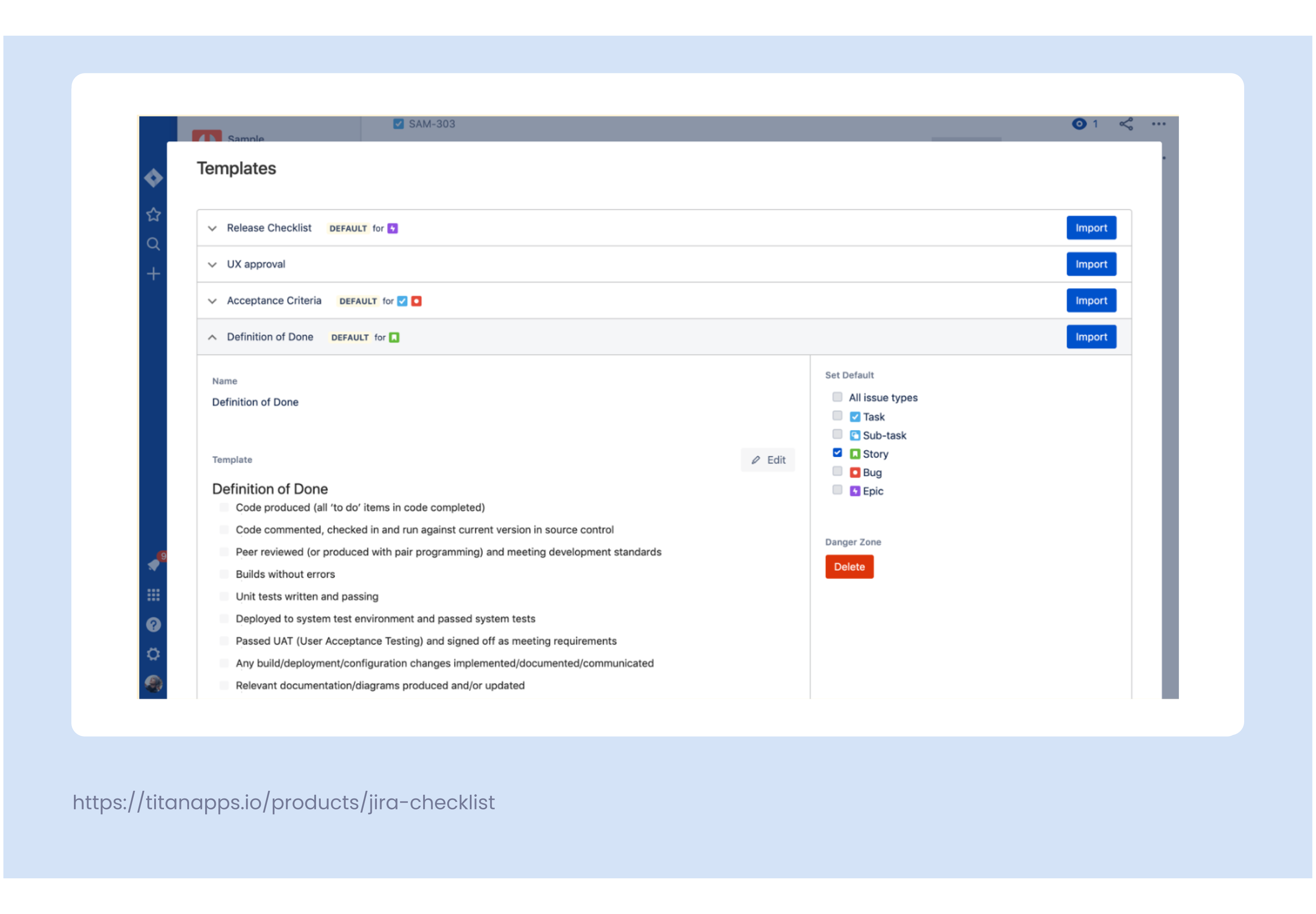
Many tasks have repetitive requirements. Filling each of them with content and context one by one is hardly a good use of anyone’s time. However, having checklists in Jira can greatly benefit your flow. Here are several examples of tasks that can benefit from a checklist.
- Definition of Done: Having a Definition of Done in every Jira work item (issue) by default ensures that the development and QA teams are on the same page when it comes to closing the work item or moving it to the next status.
- Definition of Ready: The same can be said about the Definition of Ready or DoR in Jira. A well-structured checklist will ensure that the ticket includes the information and context on a variety of crucial elements such as:
- The bugs have reproduction steps;
- The design is ready;
- A work item is estimated;
- And the features have acceptance criteria.
- Other cases: There’s a multitude of cases when generating a checklist automatically adds a lot to your Jira ticket workflow. Every task that is repetitive by nature and has a multitude of important steps is a prime candidate for automation. Onboarding tickets, for example, force new people to take a series of specific actions like signing up with their corporate email, reading company guides, or linking their GitHub. Procurement, offboarding, and support requests are great examples as well.
How to create a checklist template in Jira Cloud?
Jira doesn’t have checklist functionality by default. However, you can easily install a checklist app like Smart Checklist from the Atlassian Marketplace. The app is available for Jira Cloud, Jira Server, and Jira Data Center, plus there’s a 30-day free trial.
Start by adding Smart Checklist to your Jira instance. Please note that you will need admin rights for this step.
- Go to the Atlassian Marketplace and find the Smart Checklist for Jira app.
- Click on the yellow “Try it free” button.
- Follow the instructions of the installation wizard. This process shouldn’t take longer than a couple of minutes.
These steps will help you add a checklist for Jira:
- Go to the Atlassian Marketplace.
- Find the Smart Checklist app for Jira.
- Click on the “Try it free” button to install the checklist app.
- Follow the instructions of the instructions of the installation wizard.
Note: This instruction is for Smart Checklist for Jira Cloud.
Now that the Jira checklist app is installed, you can add some checklist templates.
- For starters, you will need to create a checklist that will serve as your template. Open a Jira work item and click on the Smart Checklist button.
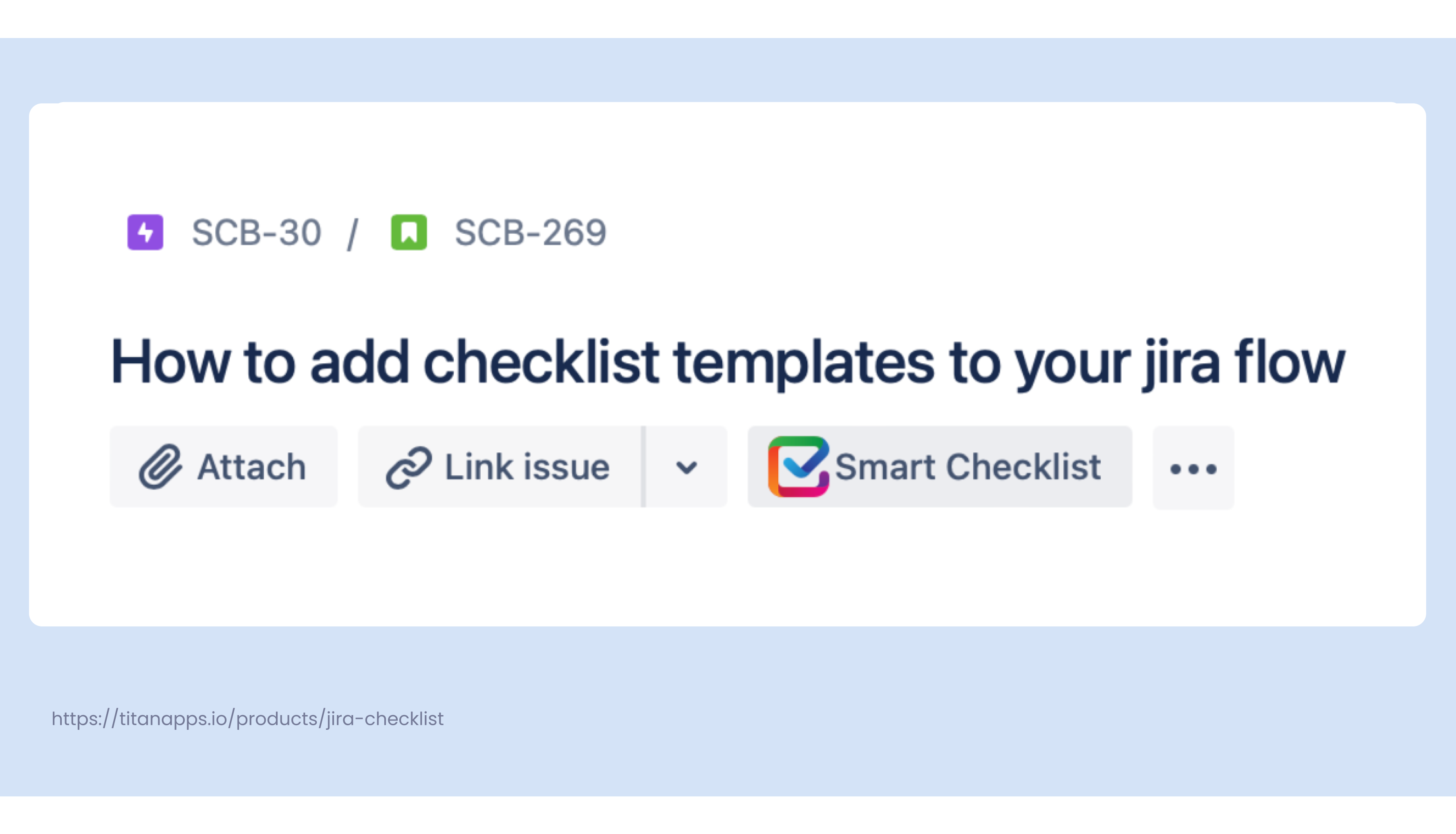
- Populate the checklist with checklist items. You can simply type in your DoD, DoR, or Acceptance Criteria. You can also add due dates and assignees to checklist items after typing in the date or the “@” sign to mention a user.
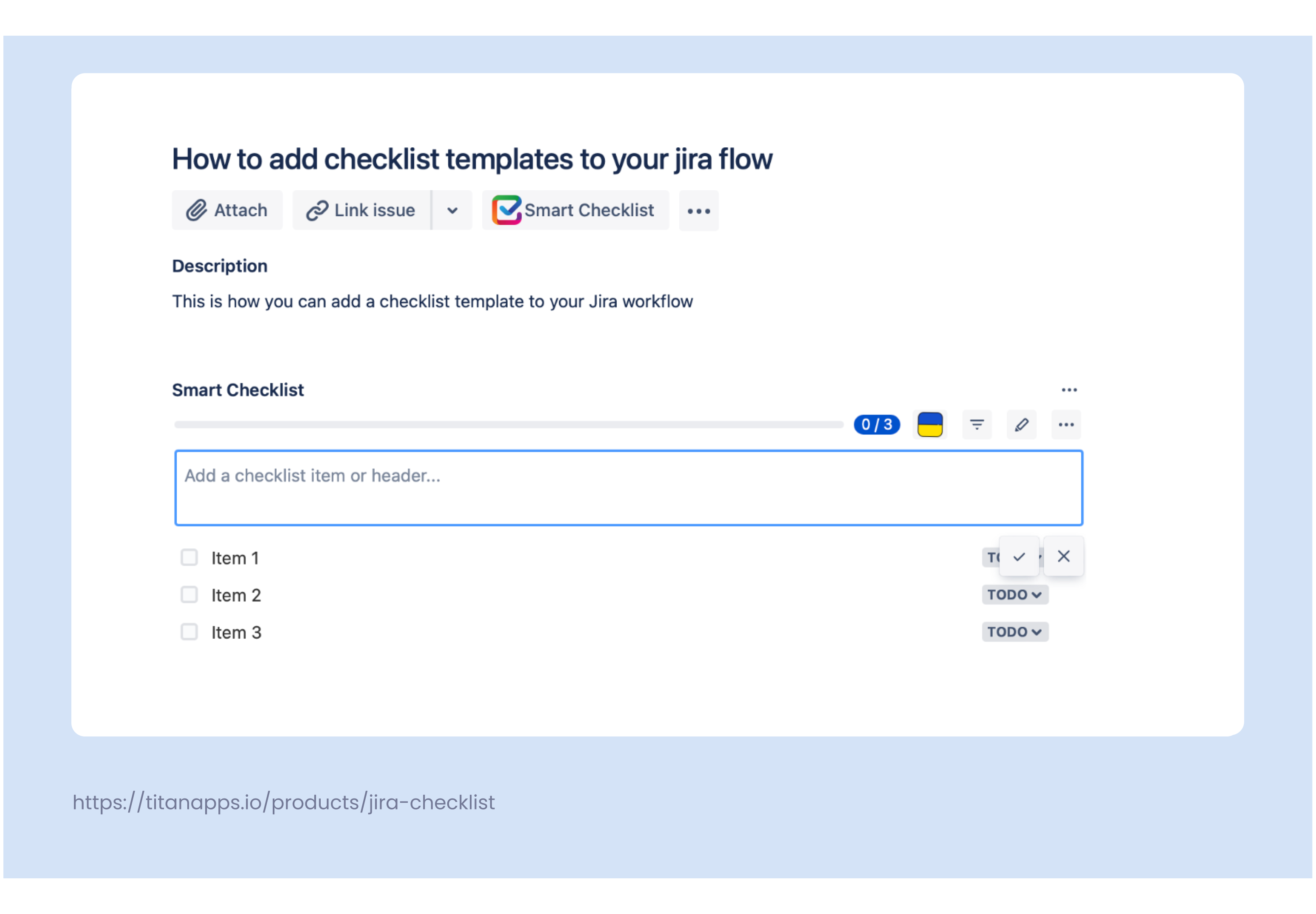
- Open the Markdown editor: If you need more formatting options, click on the button with a pencil on it. The beauty of this approach is its flexibility – you can effortlessly copy and paste a checklist from an Email, Skype message, or Slack channel and paste it into the Markdown editor. Do note that you will still need to follow the formatting guide.
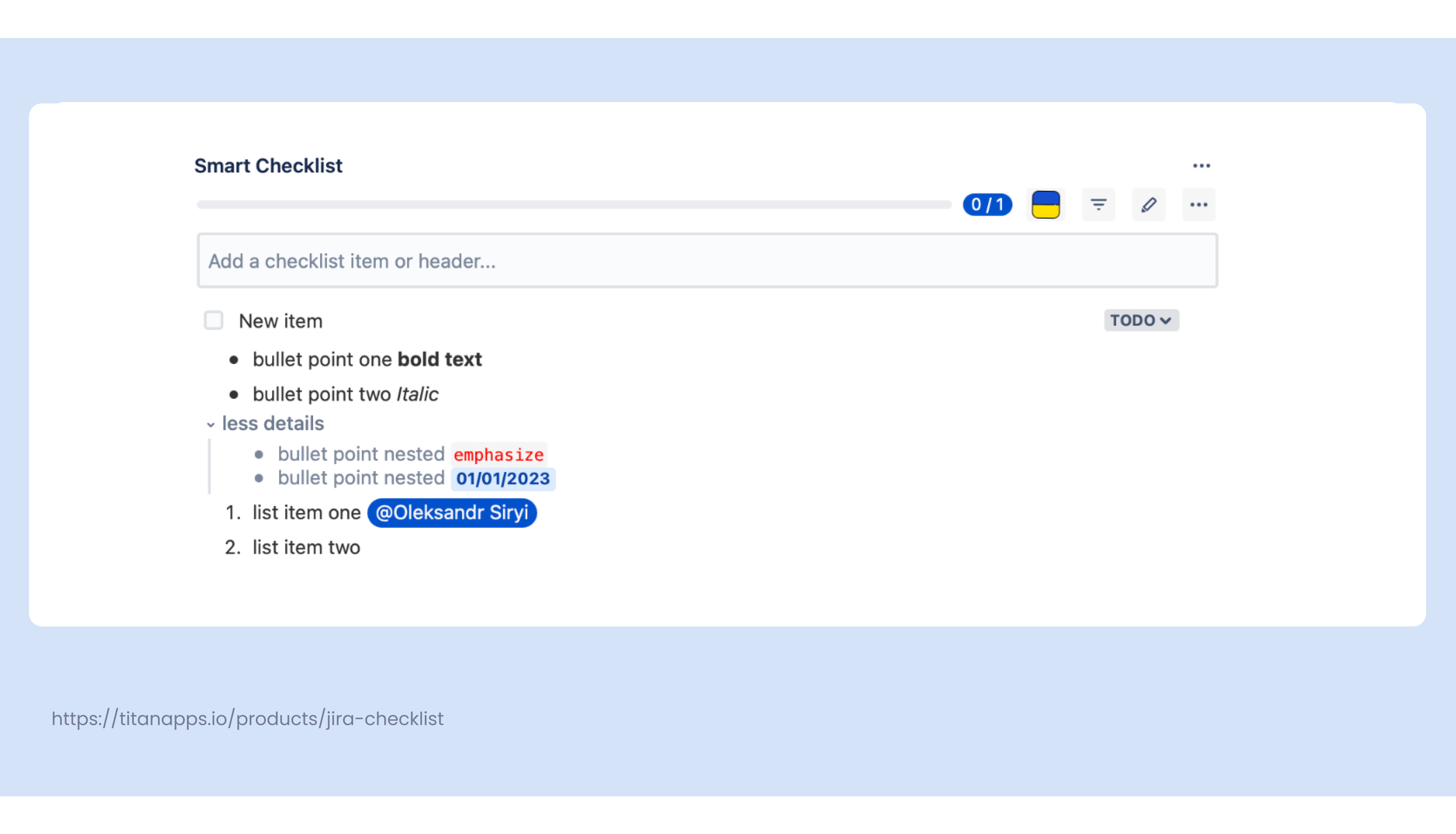
- Now that you have your checklist template ready, open the Smart Checklist menu (Click on the three dots).
- Select the option to save your checklist as a template.
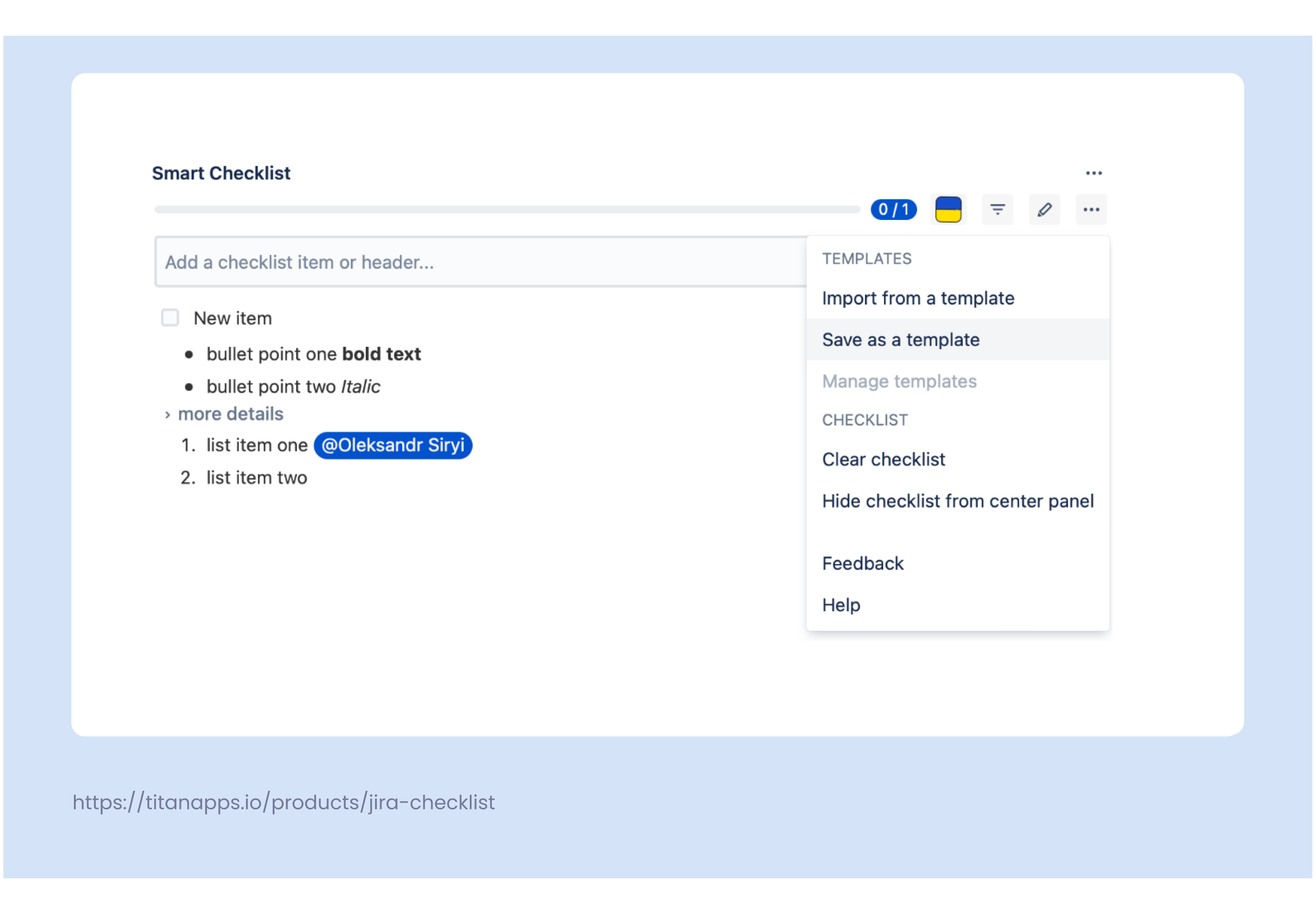
- Name your template, and click “Save”. You can use the toggle button to switch between the options of making the template global (system-wide) or not.
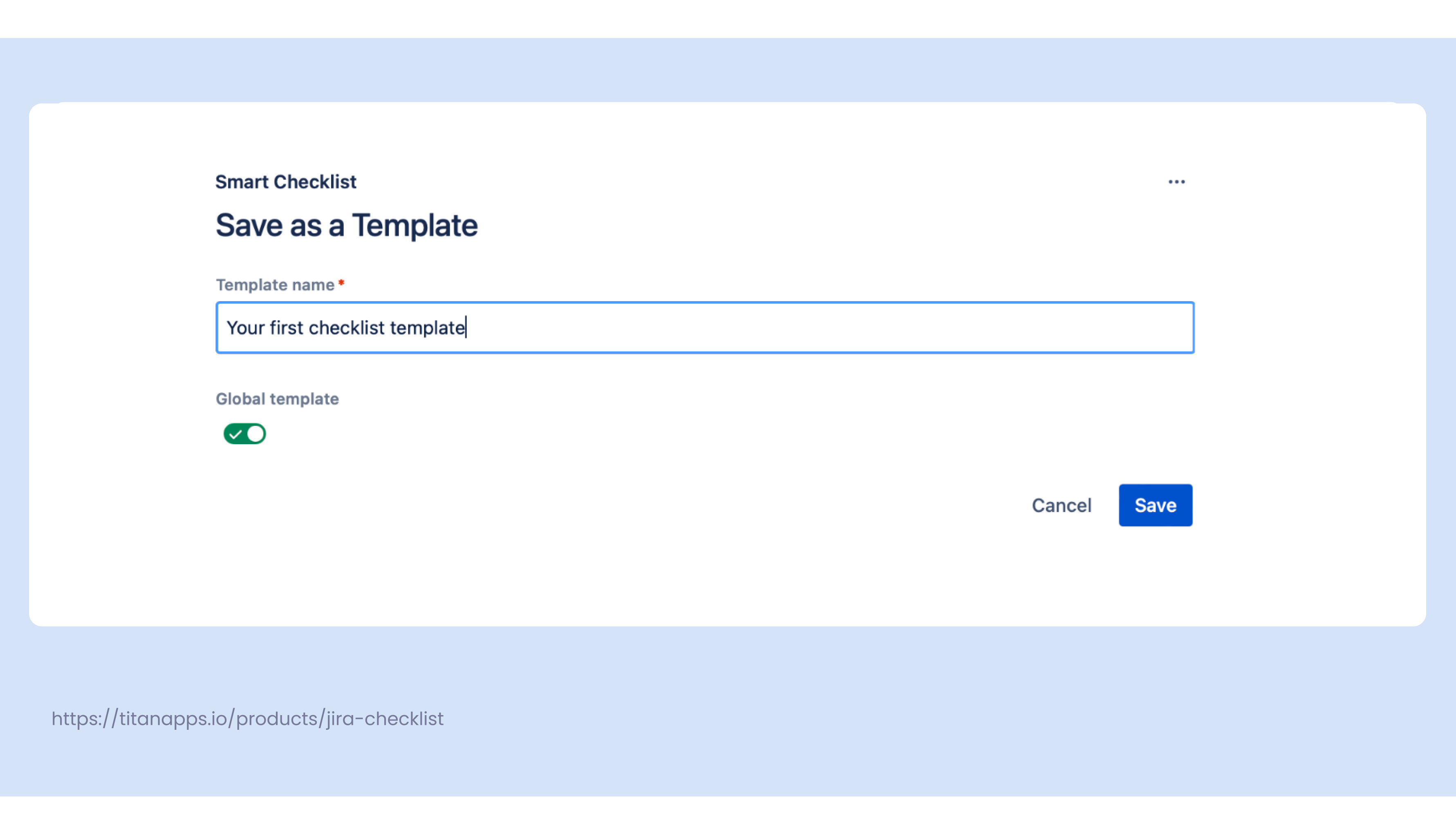
You can make as many checklist templates in Jira as you wish following this process. Please note, however, that you can only create these templates from inside the work item in the Cloud version of Jira.
How to create a checklist template in Jira Data Center?
If you are running Jira for Server or Data Center, you’ll need to add and manage checklists from the global settings.
- Open Global Settings and click on the “Manage Apps” Tab
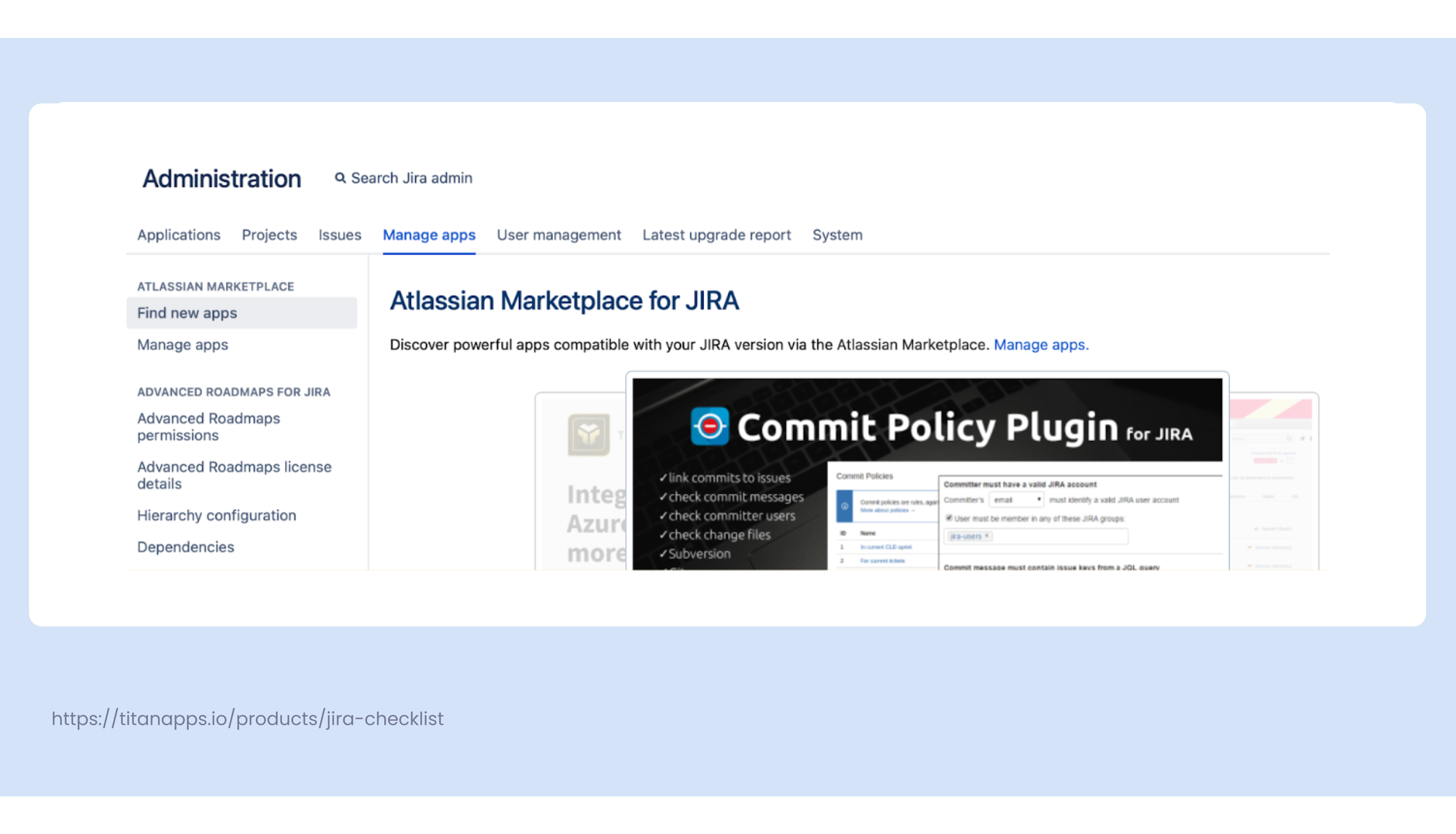
- Find Smart Checklist in the sidebar and click on “Settings”.
- You can find the checklist templates management functionality under the templates tab. You can add and edit checklist templates from here.
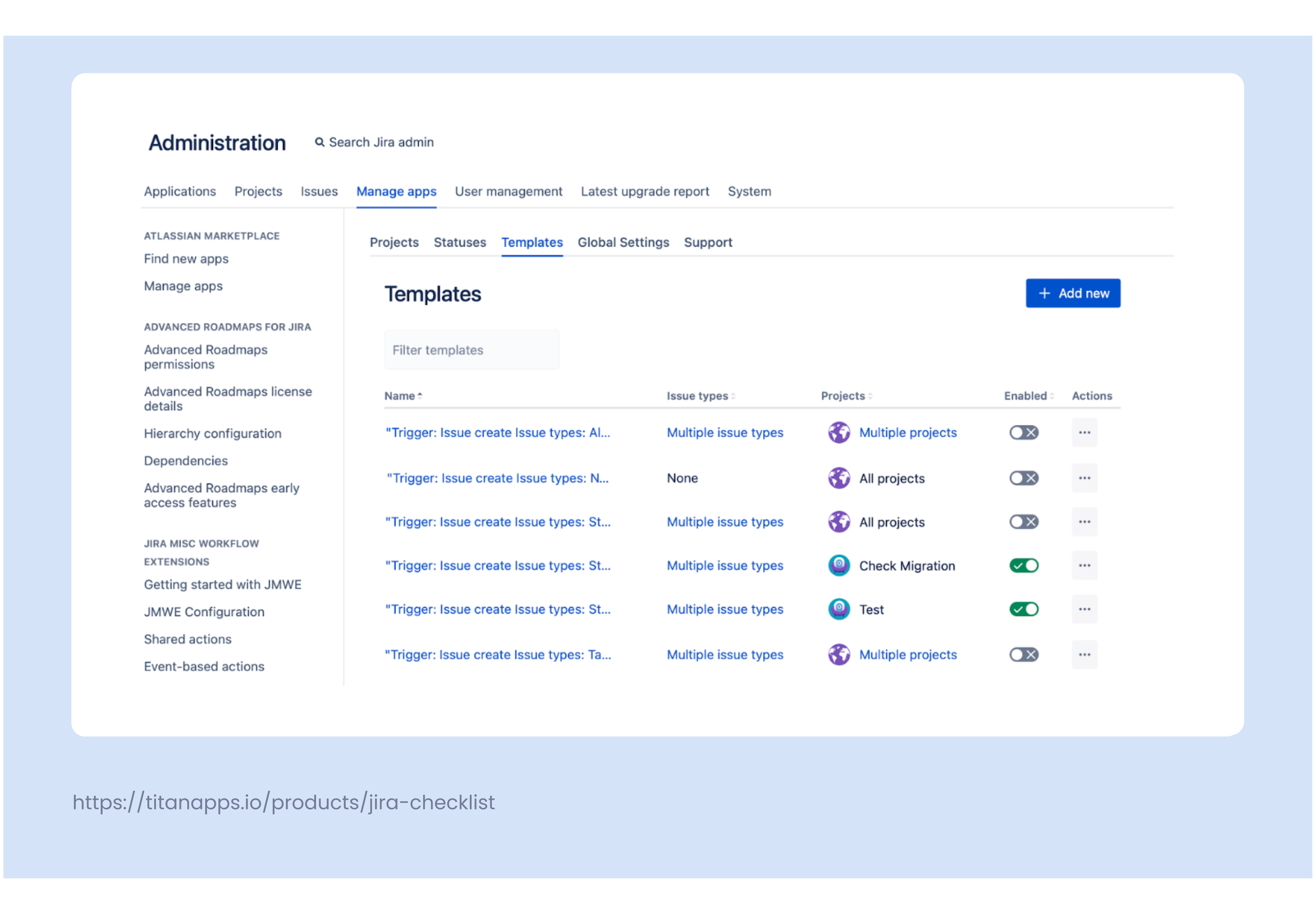
How to set a checklist template as a default per work (issue) type?
Now that you have a checklist ready, you can set it up as default per work type. This will ensure that a checklist is automatically generated whenever a new work item of a selected type is created.
- Go to the checklist options menu again, but this time select the “manage templates” option. This will open the templates menu.
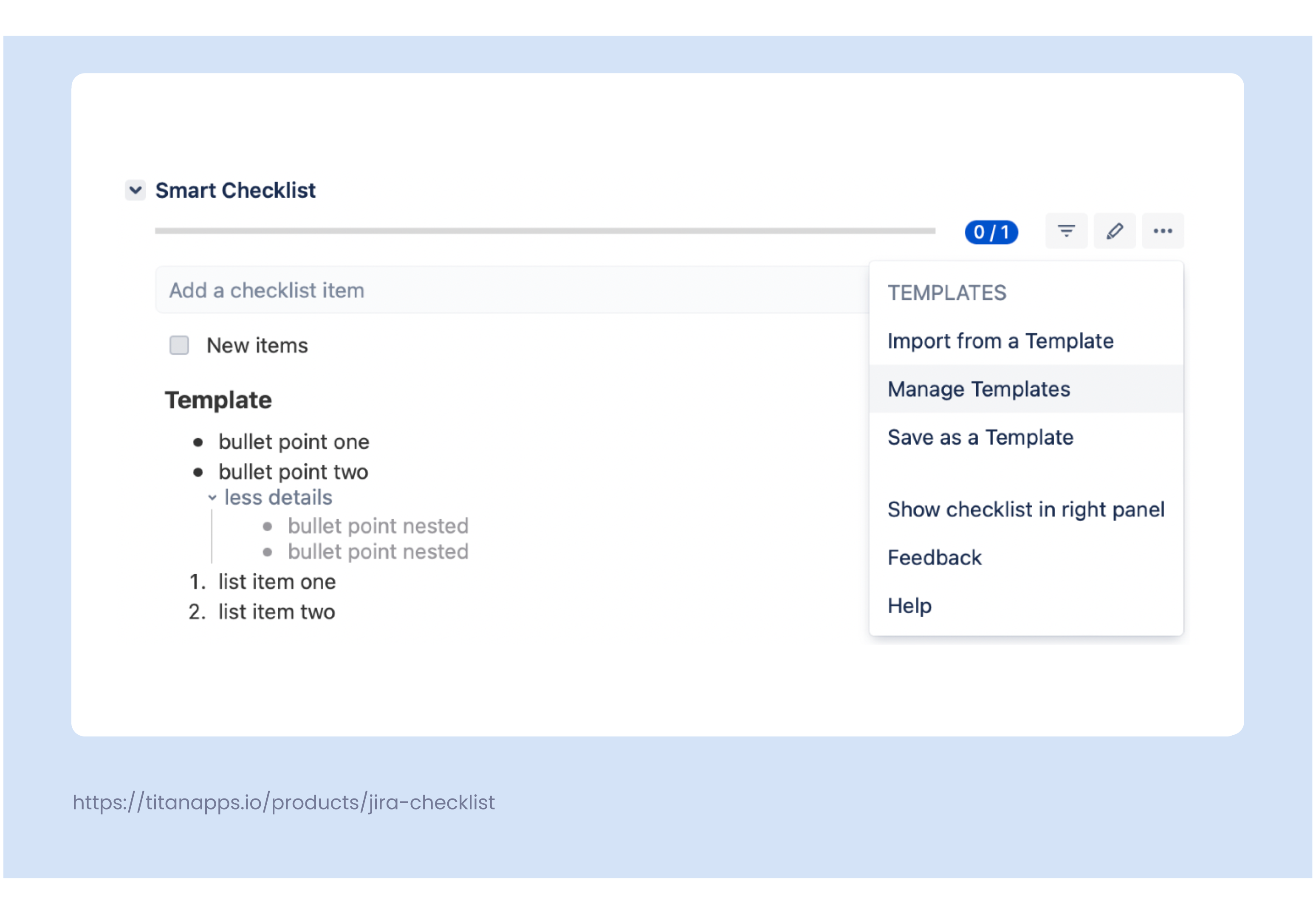
- Expand your template to see more options. You’ll be able to set your template as a default per work type – choose the option that fits your needs on the right. You can edit your template from here as well.
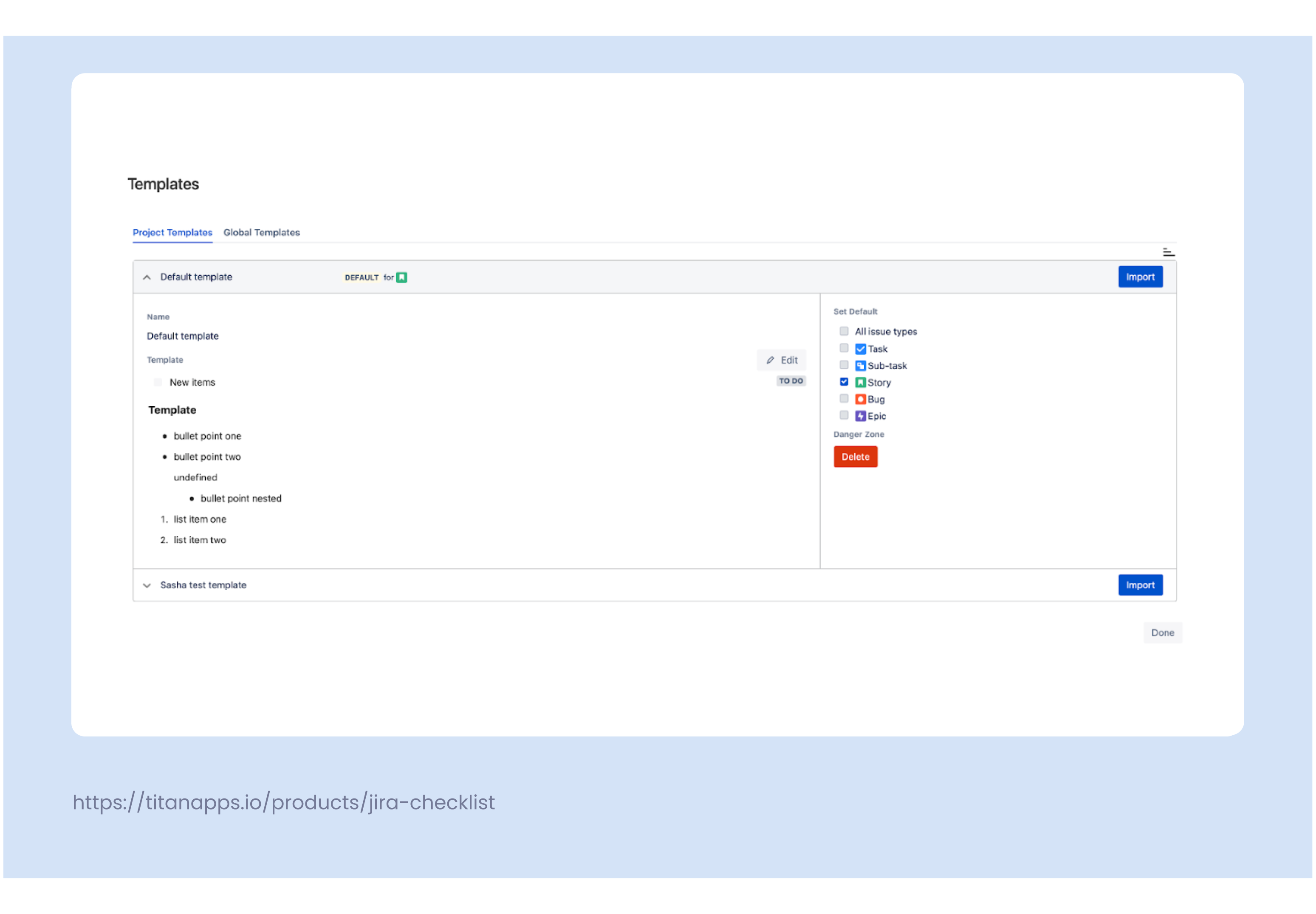
- Click “Done”. Now every new work item of the work type you have selected will be created with a checklist inside of it. You can assign multiple templates to a work type.
There’s more than one way to skin a cat. For instance, Smart Checklist is integrated with Script Runner, JMWE, and Automation for Jira. What this means is that users can set up their automation in a way where a checklist is added based on the content of a work item and their workflow setup.
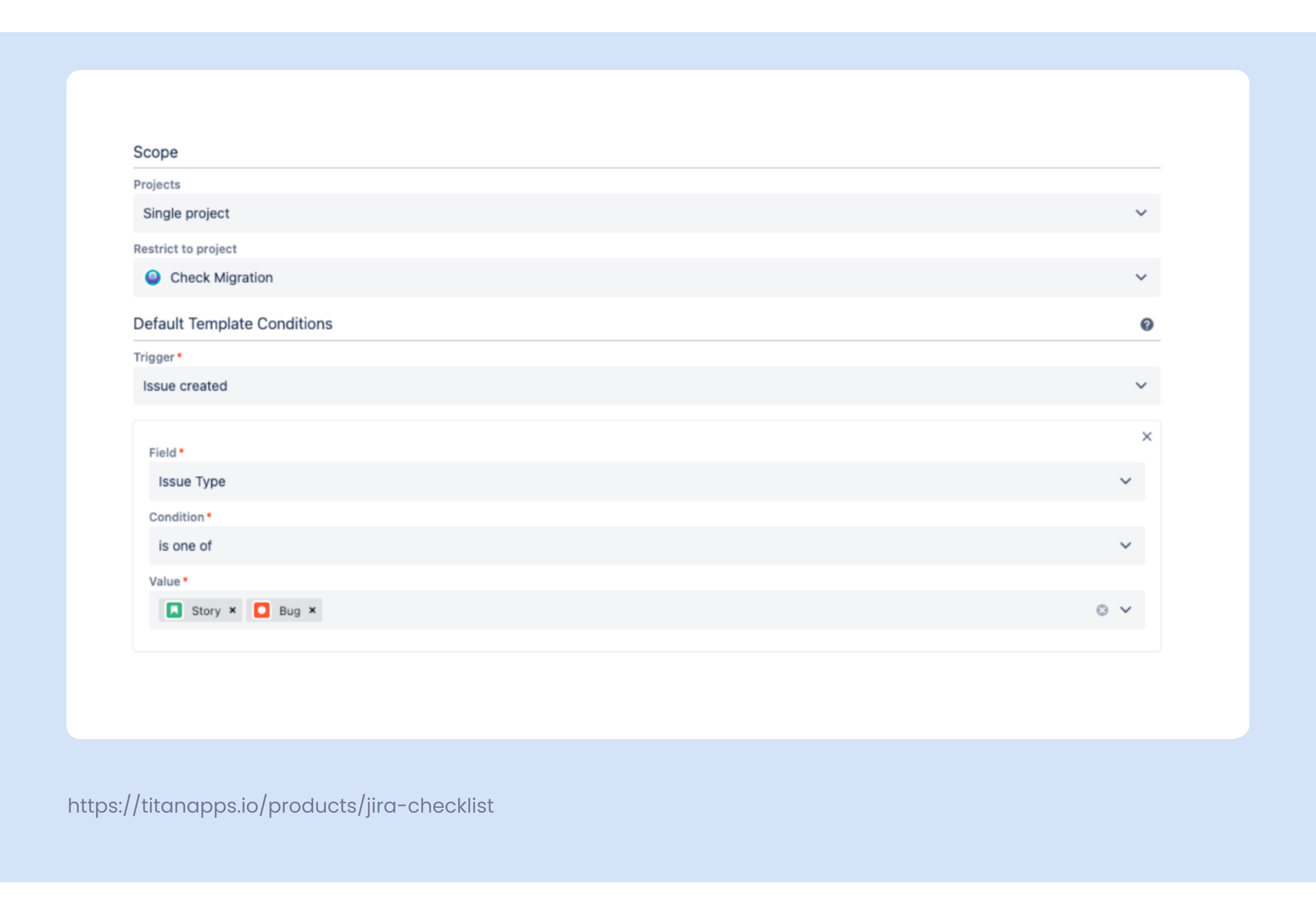
How to import checklists from other sources like Trello to Jira?
As I mentioned before, you can simply copy and paste a checklist from an external source like Slack, Skype, or Email into the Markdown editor. This can help your teams share checklists regardless of the channel of communication they are using. But what if you already have an actionable checklist in a different Project Management tool like Trello?
You’ll need to install the Smart Checklist power-up from Trello’s power-ups page or the power-up button at the right corner of the screen. Use the search bar to find our app and follow the instructions on how to install it.
Once all is done, open the Trello card with a checklist you need and click on the “Export Checklists” button under the power-ups menu, copy the items, and paste them into Jira.
This will work perfectly well if you are looking to copy one or several checklists from Trello. Please take a look at this Trello and Jira integration guide if you’d like to migrate your entire board.
Conclusion
Having a checklist is a great benefit to your workflow as it can clearly illustrate the steps anyone needs to take to successfully accomplish their task. Automating this process for work items with repetitive requirements will save you a lot of time and effort in the long run and it will help you follow best practices in Jira.
Would you line to know more tips about working in Jira more effectively?
- Here’s how you can design a Jira product roadmap
- Learn more about Jira best practices for agile project management
- Plan springs in Jira more effectively
